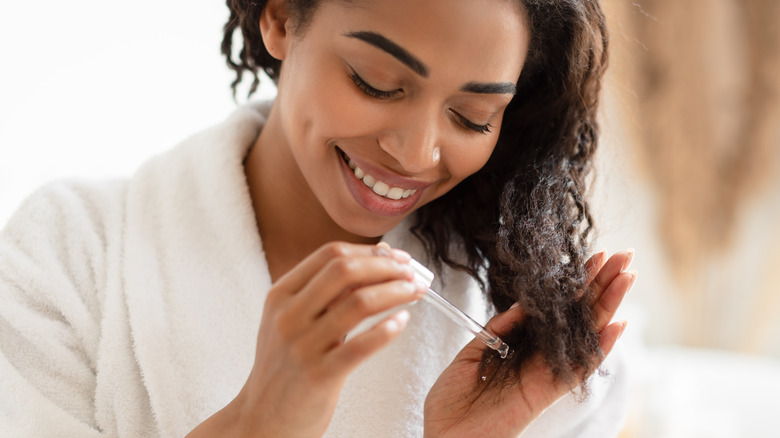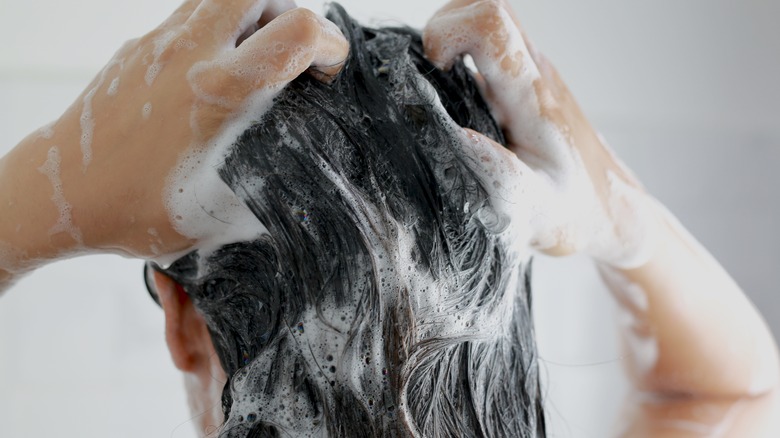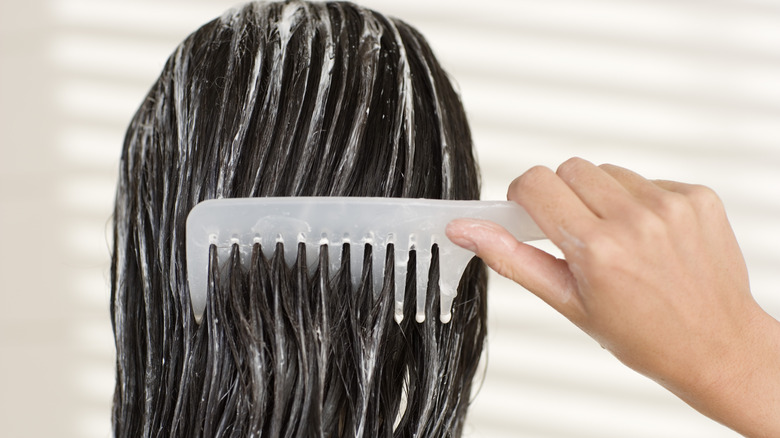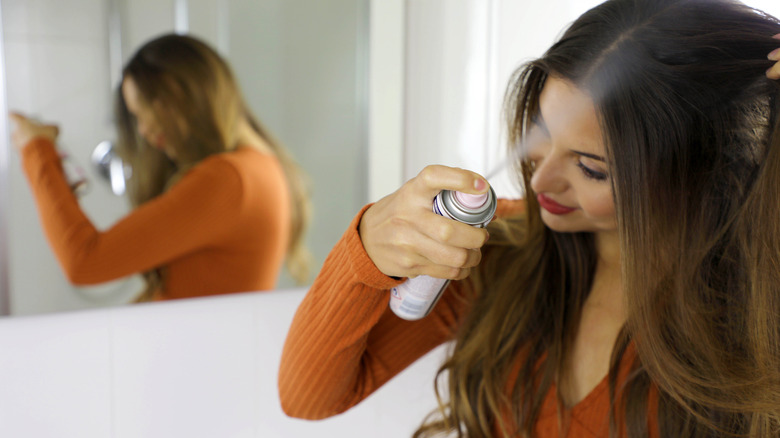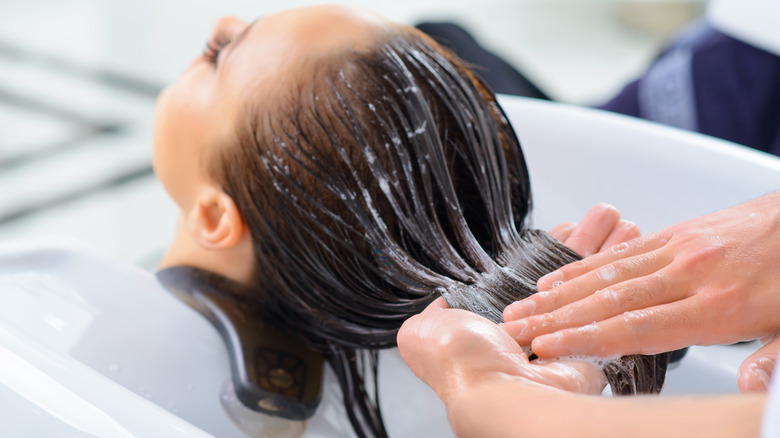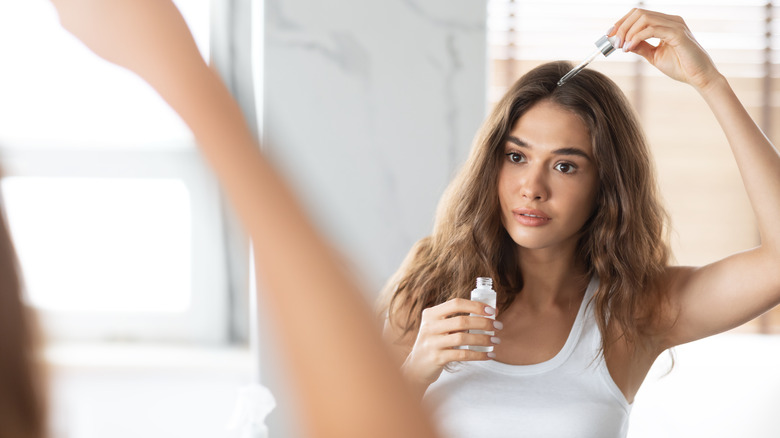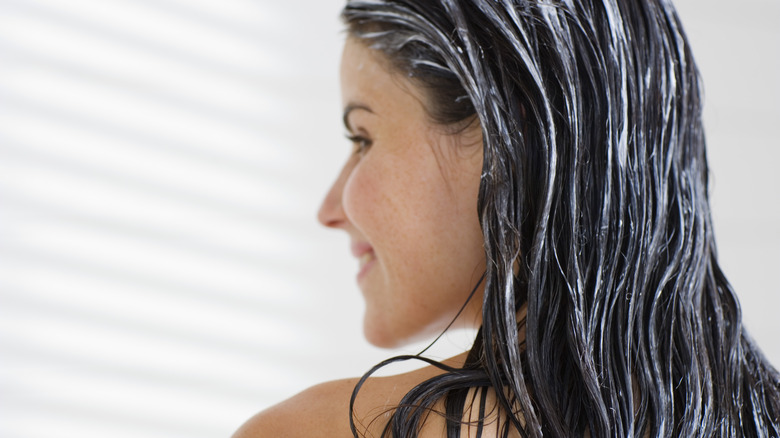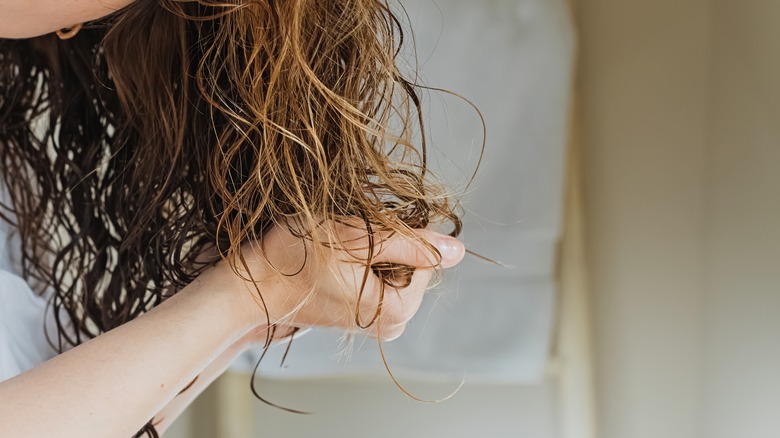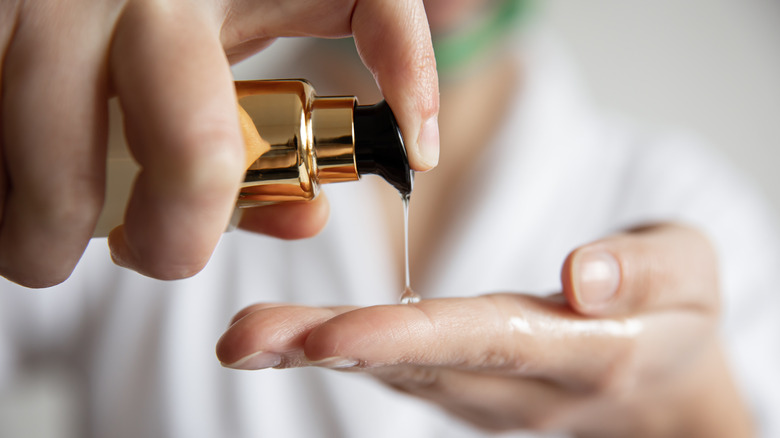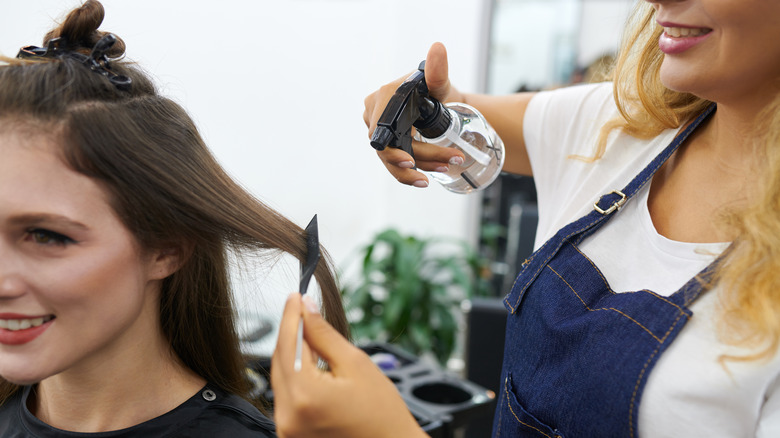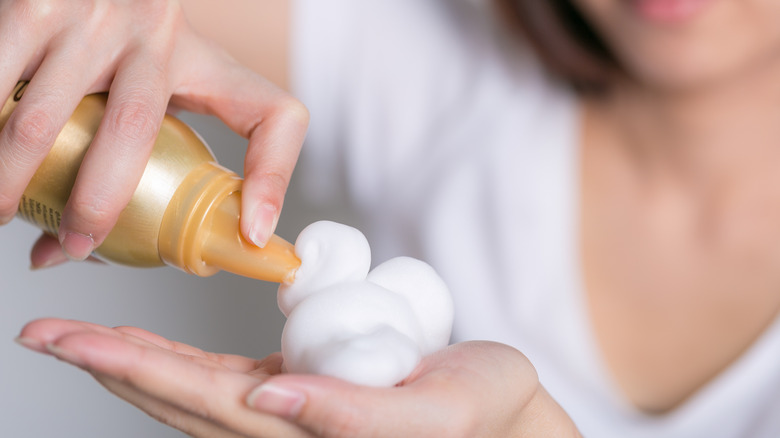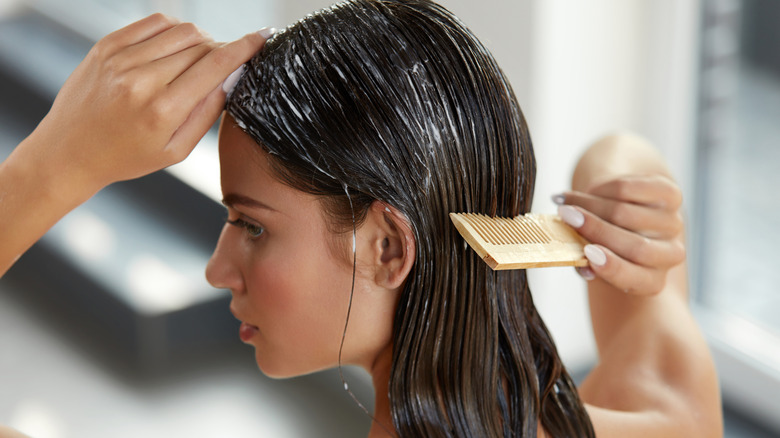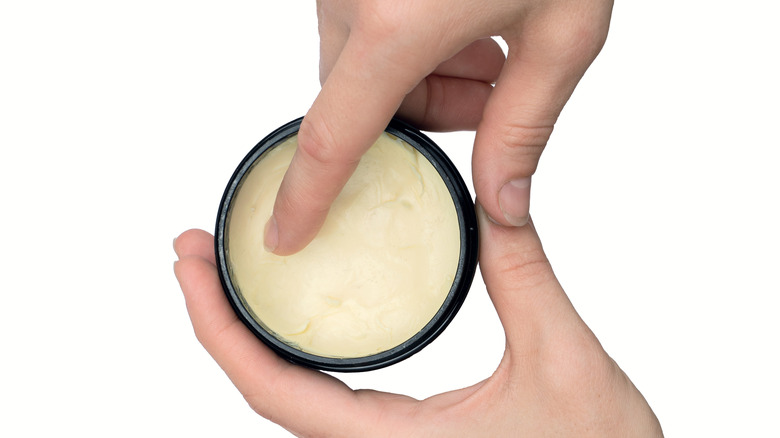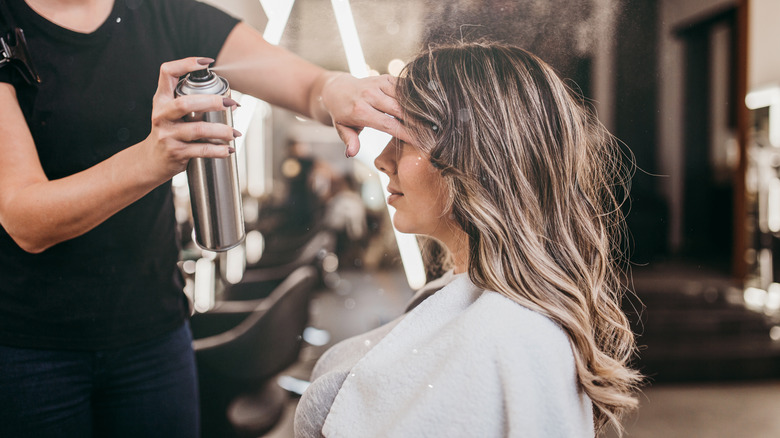Here's How Much Hair Product You Should Actually Be Using
Anyone with luscious locks knows that maintaining a healthy head of hair isn't an easy task, and somehow, the endless options of hair products on the market make it even more difficult. If you've ever spent hours scanning the hair care aisles, you know what we mean, and you know that product selection is complicated. Stuck on products? Prose has a great cheat sheet detailing which products to use on different types of hair. For example, thick curls need lots of moisture, while thin or straight hair will benefit from volumizing products and more frequent washing.
Maybe you've nailed down your products and your hair care routine, but you're still not seeing consistent results. You have gorgeous, shiny curls after one wash and a frizzy rat's nest the next. Hair that's sleek and straight one day can instantly look dry and damaged for seemingly no reason. Even if you're using the right products, you have to be using the right amount of each product to see the maximum payoff. That's right — you might actually be using too much (or too little) of your favorite hair products!
Shampoo
There's no one-size-fits-all amount for exactly how much shampoo you should use. The amount of shampoo you need will vary depending on your hair length and thickness. If your hair is short and thin, start with a quarter-sized dollop; thick or longer hair could use as much as a small handful. However, washing your hair too frequently or improperly could actually damage your tresses.
How do you know if you're over-shampooing? Healthline says dandruff could indicate you've been using too much shampoo. If your long hair seems dried out, it could be because you're shampooing the whole length of your hair — shampoo should only be used close to the scalp, as it's meant to cleanse oils from your scalp. If you're noticing any of these signs of shampoo over-use, try reducing the amount you use over your next few washes (you may also need a dandruff shampoo if your dandruff seems unmanageable). If that doesn't do the trick, you may just be washing your hair too often. A good rule of thumb is that thin, untextured hair will require multiple washes every week, while thick curls can generally get away with just one or two.
Conditioner
When it comes to conditioner, it's tempting to slather it on your hair until it's slick and smooth as a baby seal. Believe it or not, though, you can actually overuse conditioner. The exact amount you need will vary from person to person depending on your hair length, thickness, and texture, but make sure you're not over-applying. Generally, less is more.
You may be asking, what's wrong with using too much conditioner? Well, actually, lots could go wrong if you use too much or if you don't apply it correctly. Adore Beauty gives guidelines on how to condition different types of hair. Thin hair will benefit from smaller amounts of conditioner (between a dime-sized and nickel-sized dollop) applied away from the scalp to prevent product buildup and greasy strands. The curlier and thicker your hair is, the more conditioner you'll need (a nickel-sized drop or larger). If you notice product buildup on your scalp (FYI: If it falls from your hair easily, it's dandruff; white flakes that stick to your hair are probably the result of product buildup.) or your hair feels heavy, it could be the result of using too much conditioner.
Dry shampoo
Depending on your hair type and how frequently you wash, you may not even need dry shampoo! On the other hand, some hair types (think: thin, straight, oil-prone hair) hesitate to leave the house without a can of dry shampoo in their bag. For these hair types, dry shampoo is a necessary miracle worker. When used improperly, though, your dry shampoo could actually be doing more harm than good.
Dry shampoo is truly a lifesaver when used correctly. In this case, "correctly" means "sparingly." Pureology suggests you only use dry shampoo once between hair washes. Why? Well, using too much could cause the product to build up on your scalp, which is both unsightly and uncomfortably itchy. Apply it in small sprays (one spritz per section), and use your fingers to work it through your roots before applying more. A little bit goes a long way, and you'll probably even find you need less dry shampoo than you thought.
Hair mask
Hair masks are treatments applied to wet or damp hair to restore hydration. Sounds great, right? Sounds so great, in fact, that you might be tempted to use one daily or hourly, even. After all, when it comes to hydration, more is better, right? Unfortunately (or maybe fortunately for your wallet), hair masks are another product where less really is more.
In most cases, you should use your hair mask about once a week, according to Mane Addicts. If you're trying to repair really dry or damaged hair, you could up the frequency to twice or even three times a week until your hair starts seeing results. Then, use the mask just once a week to maintain your hair health. When you apply, follow the instructions on the packaging for how long to leave it on. One of the biggest hair mask mistakes you can make is leaving it on for too long (or not long enough!).
You should also make sure you're buying a hair mask suited to your specific needs. While some hair may need intense hydration, other types might benefit more from a protein treatment. In terms of how much to apply, most hair masks will be applied to damp hair straight after shampooing, in which case you won't need too much to distribute it evenly. Follow the instructions on the mask, and you should see your hair improve within a few uses.
Hair oil
Now, we're not talking about the practice of hair oiling here (which involves soaking the hair in oil to stimulate growth and add or maintain moisture and shine). We're just talking about using hair oil, which you'll find yourself reaching for if you deal with flyaways or general frizziness.
The type of oil you'll need will vary depending on your scalp's condition. If your hair tends to be more on the oily side, Hairstory says you shouldn't shy away from using hair oils — just make sure to get one that's lightweight and apply it sparingly. Drier hair and scalps will benefit from an oil that's a bit heavier, but you should still be cautious about over-applying — it could make your strands look greasy. If you're using hair oil to tame flyaways, add some shine, and/or address general dryness, a few drops applied to damp hair post-wash should suffice. Rub a few drops on your hands and rake them through your damp hair — it probably won't feel like you're doing much in that moment, but once your hair dries, you should notice fewer flyaways.
Deep conditioner
Curly hair girls (and guys!) probably have a near-intimate relationship with this holy grail hair product. Deep conditioner gives your hair that extra boost of shine and moisture that you'll find it thirsting for, especially in the drier months. As far as application frequency, DevaCurl recommends deep conditioning every week for the healthiest curls. Again, you don't want to overdo it with the deep conditioner, as this could lead to product buildup and could even imbalance your hair's nutrients.
The exact amount of deep conditioner you'll need will, again, depend on how long, thick, and textured your hair is. Generally, you'll want to saturate your hair pretty well with the product, especially if you're dealing with particularly thick, damaged, or curly hair. To do this well, separate your hair into sections, and work a small amount of product through each section, adding more as needed until your hair is saturated. Your product should tell you on the bottle how long to leave it in, but a general guideline is to soak your hair for 30 minutes. You could amp up the effects of your deep conditioner by wrapping your hair in a shower cap and/or applying heat to it. If you want to give your hair maximum moisture, you could leave it in overnight, as well.
Curl cream
Again, anyone with curly hair is no stranger to curl cream. This product adds definition, support, and shine to your curls when used correctly. When used improperly, though, it can cause your hair to feel heavy, greasy, and even brittle. Lots of curly-haired folks make mistakes with curl cream when starting out, so if you're new to taking care of curls, don't go in blind — follow these guidelines to get the most out of your curl cream.
First, you should apply curl cream to wet hair. Like, very wet hair. Try applying it at the very end of your shower, before drying your hair at all. Start with a quarter-sized amount for short to medium-length hair, flip your head upside down, and finger-comb the product through your curls. Then, use your hands to gently scrunch and squeeze your curls. You're looking for your curls to "clump" together, and you shouldn't see individual strands. However, you do want to avoid your roots so the top of your head doesn't feel heavy, according to Only Curls. Don't overdo it on the cream, though — you don't want to see suds when you're scrunching.
Hair gel
You probably won't find yourself reaching for the hair gel unless you're trying to style shorter hair. When it comes to hair gel, less is more here as well. You'll know you've used too much if your hair looks greasy, feels crunchy, or if you notice buildup on your scalp. Head & Shoulders says other signs of overusing gel can include a dry scalp, scalp irritation, and dandruff.
When using gel to style and hold shorter hair, you shouldn't need much more than a dime-sized amount to start. Rub the product between your hands and comb your hands through your hair to style it as desired. Your hair should stay in place and feel slightly stiff without looking slick. If it looks slick, you may have used too much product. If you're a chronic gel over-user or just use gel very regularly, you'll want to make sure you're regularly using a deep-cleansing shampoo, as this will help totally remove the gel from your hair follicles (and can clear any scalp buildup) between washes.
Heat protectant
If you regularly use heat tools to style your hair, we beg you, don't sleep on heat protectant! While SkinKraft notes that a heat protectant can't totally protect your hair, it can help reduce the damage heat tools cause to your hair, including damage to your hair color and texture. A good heat protectant spray acts as a kind of barrier between your hair shaft and the heat tool; without it, your hair is much more susceptible to dryness, breakage, and dulling.
How much heat protectant spray should you apply? The most important thing is to apply it evenly throughout your hair to ensure a uniform look once you're done styling. To do this, we recommend sectioning your hair before applying heat protectant, especially if your hair is thicker. Then, spray one spritz of the heat protectant per section, and comb it through each section of your hair. You don't need to use a lot of spray for it to be effective — after all, you don't want your hair to be too wet when you're flat-ironing it. However, you probably won't run the risk of using too much unless your hair is very thin.
Hair mousse
Need to add volume, texture, or lift to your tresses? Then a hair mousse may be just the thing for you. Because mousse is lighter and airier than styling gels or creams, it'll give you that much-needed definition without weighing your hair down. Any hair type can benefit from using mousse, but hair that's prone to greasiness or heaviness after using other styling products may particularly love it.
The amount of mousse you need will depend on how long, thick, and textured your hair is, but you might find you need more than you think since mousse is an airy product. Schwartzkopf recommends using between a golf ball and tennis ball-sized amount for most hair lengths and types. Make sure you're applying it to wet hair, and you shouldn't need much more than that. Using too much mousse could dry or damage your hair, so err on the side of using less, especially when you're first starting out. After using mousse, you can let your hair air dry or style it as you normally would — you should notice more volume throughout.
Leave-in conditioner
Leave-in conditioner is a lifesaver if you have textured hair, especially if it tends to be dry or damaged. The name is pretty self-explanatory: Leave-in conditioner is a conditioner that you leave in your hair after you wash it. It helps your hair lock in moisture until you wash it again and can support shine and hydration, prevent flyaways, and define curls.
Leave-in conditioner isn't a one-size-fits-all product — it comes in about as many varieties as your standard shampoo and conditioner. The exact amount you need depends on more than just your hair type, length, and thickness — it also depends on what formula you're using. Thinner hair will benefit from a lighter leave-in, like one that comes as a spray or a milky cream. Thick hair will benefit from cream formulas, and if yours is particularly prone to dryness or breakage, you may want to go for a thicker cream formula. Follow the package instructions when it comes to how much product to use. Generally, you'll need a few spritzes of spray and a quarter-sized amount of cream formulas. You'll know you've applied too much if you see buildup on your scalp or if your hair feels heavy after it dries. As for how often to use it, your hair will probably tell you how much it needs — some types may need to use it after every wash, while others may notice their hair feeling greasy when it's used too often.
Pomade
New to pomade? Don't worry, we don't blame you if you've never used it. Pomade is typically used to give shorter hair a slick, stiff, sleek style, and isn't quite as strong as gel. If you're looking for a flexible hold that isn't firm to the touch, we recommend opting for pomade rather than gel.
Into the Gloss says a penny-sized amount of pomade should suffice for most short hair styles and types. Of course, you can alter this amount as needed, but remember that you're not going for a super stiff style with pomade– use just enough that your hair stays in place and gains some shine.
If you try pomade and it just isn't giving you enough hold, you could also opt for a wax. Hair wax will be harder to wash out of your hair, but it offers a stronger hold and more staying power than pomade. Of course, if you're still stuck between pomade, gel, and wax, you could always consult your stylist and see what they recommend for your hair type and preferred style.
Texture spray
Hair texturizing spray is great for when you want that messy-on-purpose, beach-wavy, woke-up-like-this-but-I-look-great hair. It's like the garnish you add to a yummy dinner — it may not be totally necessary, but it adds an extra touch of something special to the dish (or, in this analogy, your hair). In fact, Living Proof recommends texture spray to give added life to any hairstyle, from ponytails to braids to simple flowing curls.
How much you use will depend on what look you're going for — start with a little and build it up if needed. If you're going for an all-over textured, volumized 'do, apply the texture spray throughout your hair by sectioning it and spraying the whole hair shaft of each section. Maybe you just need some extra volume near the root of your hair, though. If that's the case, spray some texturizing spray close to the root of your hair and work it through the top of your hair shaft with your fingers. When applied correctly, your hair shouldn't look or feel greasy, crunchy, or weighted down — if it does, you may be using too much product.
Hairspray
Ah, hairspray: The miracle formula we'd use with reckless abandon to secure an updo before homecoming. If you've used hairspray, we're willing to bet you've overused it at least once, probably to practically glue dozens of bobby pins to your 'do. No shame, friend — we've all been there. If you're still securing your hair with a copious amount of hairspray, though, we recommend you dial it back a bit, as using too much hairspray can leave your hair dry, damaged, brittle, and with a serious case of product buildup.
You don't need to ditch the hairspray completely, though, because you can probably get away with using less than you think. Start small with a lightweight hairspray formula, and spritz a dusting of it on your finished style. If that doesn't do the trick or your hair doesn't feel secure, use a little more or switch to a spray with a heavier hold. You might face a little trial and error when it comes to what type of hairspray to use and how much, but as with many other products on this list, less really is more.
